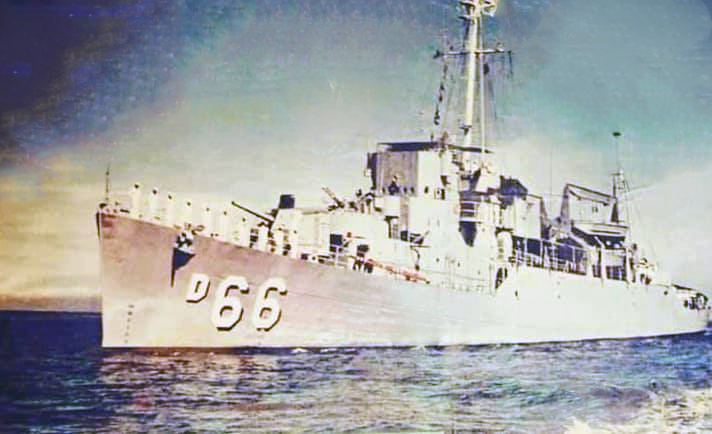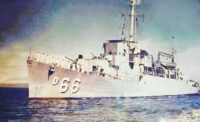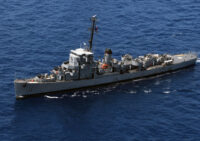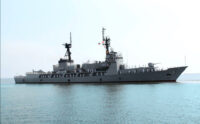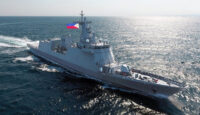From the past to the present, in common naval parlance, the Flagship is usually where the Admiral has its Flag.
Throughout time, the Flagship is also noted for its armaments, speed, and capability.
Sometimes the Flagship is also the lead ship of a Navy’s particular class of vessel specifically if it is the most well-armed or the biggest in its fleet.
As for the Philippine Navy, we trek to time to look into our Flagships from the Revolutionary period to the Present day.
REVOLUTIONARY PERIOD
SS BULUSAN. The Steamship Bulusan became the First Flagship of the nascent Filipino Navy, owned by Don Eulalio Villavicencio of Batangas, the Villavicencio Family supported the revolution by donating the ship for the revolutionary cause. SS Bulusan was skippered by Merchant Marine Captain Simplicio Agoncillo Orosa, who also placed himself under General Emilio Aguinaldo’s command. SS Bulusan would support the revolutionaries and would ply the route of Manila, Lemery, Batangas, Calapan, Mindoro, and the Visayas. SS Bulusan was supported by 8 captured Spanish steam launches and 5 steamships, namely: SS BATANGAS, SS BALAYAN, SS PURISIMA CONCEPCION, SS TAAL and SS TAALENO of the Filipino Merchant Marine donated by their owners Don Leon Apacible and Don Manuel Lopez. SS Bulusan would later be sunk off the coast of Masbate in 1896.
PINNACE MAGDALO. The Pinnace was gifted by Admiral George Dewey to General Emilio Aguinaldo and became the Flagship of the Revolutionary Navy for a few days before the arrival of the FILIPINAS. General Aguinaldo has informed Admiral Dewey that he has a barge being repaired at the Shipyard and he plans to arm it and utilized it to attack the Spanish positions in Intramuros. On this, Admiral Dewey informed General Aguinaldo that no attack would commence unless the bulk of the American Forces arrived. To smooth things up, Admiral Dewey gifted the PINNACE of the Spanish Cruiser Reina Cristina to Aguinaldo. It was christened MAGDALO and utilized as Transport of the Revolutionary Navy.
FILIPINAS. An 800-ton steamer of the Compania Tobacco De Filipinas seized by its Filipino Crew who killed the Spanish Officers. The Group was led by the Ship’s Second Officer Cuban Vicente Catalan who took over as the Ship’s Captain and proclaimed himself Admiral of the Filipino Navy.
Making themselves under the Command of General Emilio Aguinaldo, Vicente Catalan was commissioned as a Navy Captain in the Philippine Revolutionary Navy. The FILIPINAS was then armed with Cannons captured in Cavite and provided Naval Gunfire Support to the Revolutionaries as well as a Transport Ship of the nascent Filipino Navy.
She was later named LUZON and was active during the Second World War until it got damaged and sunk by Japanese air attack. She was then refloated by the Imperial Japanese Army and converted as a Patrol Ship/Cargo Ship and renamed HOEI MARU with Japanese Hull Number 342. She was sunk off the Yellow Sea near Jindo Island on 03-July-1945 by a Naval Mine laid by US Aircraft.
WORLD WAR II
CASIANA/BANAHAW. Acquired from the United States by the Commonwealth Government in 1936, she was designated as the Presidential Yacht during the Critical days of the War in 1941. She traveled back and forth to Corregidor for personnel and transfer of supplies. Technically, she was under the Philippine Coast Guard at that time. She was sunk in Corregidor in December 1941 during a Japanese Bombing.
Q-111 LUZON (British Thornycroft Built 55m Torpedo Boat) was also considered as the Offshore Patrol’s Flagship being the lead ship of her class. She was scuttled off Looc, Cavite, and Nasugbu, Batangas on 09-April-1942.
The following year in 1943, she was refloated by the Imperial Japanese Navy and made into a Patrol Boat, but was again sunk in 1944 by a US Navy airstrike off Manila Bay.
POST WORLD WAR II TO PRESENT
Before the arrival of the Patrol Craft Escorts (PCE) in 1948, the first ships transferred to the Philippines became our earliest naval vessels. After the war, there were 5 former US Coast Guard Bouy and Lighthouse Tenders: USCGC ANEMONE, ORCHID, SEQUOIA, ARMISTEAD RUST, and TULIP which were often used by President Osmena and President Manuel Roxas. ORCHID was the Presidential Yacht and Flagship.
DALISAY (President Manuel Roxas). APO (President Elpidio Quirino); PAG-ASA (President Ramon Magsaysay).
SANTAMARIA/CORREGIDOR/INCORRUTIBLE/PAG-ASA (President Carlos P Garcia); MOUNT SAMAT (President Ferdinand E Marcos). A notable ship with several name changes, she was the former USS Quest an Admirable Class Minesweeper transferred by the USN during the incumbency of President Roxas. This is the ship were President Elpidio Quirino held meeting with the cabinet secretaries and presidential staff during the critical days of the Korean War.
RPS LAPU-LAPU (President Carlos P Garcia). As Philippine Navy Flagship from 14-February-1959 until 30-December-1961. She is a Japanese built vessel as part of the war reparations act. Her First Skipper is LCDR Manuel Mandapat PN. Her designation as Flagship of the Philippine Navy was terminated on 31-December-1961 upon orders of President Diosdado Macapagal. RPS LAPU-LAPU would also undergo several name changes to RPS ROXAS during the time of President Macapagal on 09-October-1962 in honor of President Manuel Roxas. During the incumbency of President Ferdinand Marcos, she was named RPS THE PRESIDENT, and again as BRP ANG PANGULO. During the administration of President Gloria Macapagal Arroyo, she was renamed again to BRP PAG-ASA on 06-March-2009. By the Administration of President Benigno S Aquino III, BRP PAG-ASA was again renamed to BRP ANG PANGULO. The Ship is still in active service and retains her name and function.
RPS RAJAH SOLIMAN (D-66) was a High-Speed Attack Transport/ Buckley Class Destroyer Escort that took on the role of Flagship from 31-December-1959 until 29-June-1964 when she was sunk off Bataan during Typhoon Winnie. Her First Skipper was CDR Geronimo Cabal PN, followed by CDR Godiardo G Nonato PN.
RPS DATU KALANTIAW (PS-76). A Cannon Class Destroyer Escort replaced the Rajah Soliman as Flagship on 15-December-1967 until 21-September-1981 when PS76 was sunk off Calayan Islands.
RPS RAJAH LAKANDULA (PF-4). The sole Edsall Class Destroyer Escort Radar Picket took over as the Fleet’s Flagship in 1981 until her decommissioning in 1988.
BRP RAJAH HUMABON (PF-6/PS-78/PF-11/PS-11). Another Cannon Class Destroyer Escort acquired in 1976, Rajah Humabon took on as the Flagship with the decommissioning of BRP Rajah Lakandula (PF- 4).
Among the skippers who became its flag officers were:
- Vice Admirals Eduardo Ma. Santos, Emilio Marayag Jr., and Ruben Domingo;
- Rear Admirals Eriberto Varona, Manuel de Leon, Gilmer Batestil, Edgardo Tamayo, Isabelo Gador, Jaime Bernardino, Joseph Rustom Peña, Jose Renan Suarez, Leopoldo Alano, and Giovanni Carlo Bacordo; and
- Commodores Nicanor Hernandez, Leon Oribello, Edsel Lumawag, Salvador Esguerra, Paterno Labiano, Teddy Pan, Antonio Mendoza, Virgilio Garcia, Edwin Mackay, Nichols Driz, and Adeluis Bordado.
PS-78 was decommissioned in 1993, but due to pressing needs, she was re-commissioned with a new machinery and hull number to PF-11 in 1995.
There were plans to re-commission the BRP ANDRES BONIFACIO (PF-7) as an Auxiliary Fleet Flagship but it did not push through.
PF-11 took on the Flagship role until the arrival of BRP Gregorio Del Pilar in 2011.
BRP GREGORIO DEL PILAR (FF-15/PS-15). On her arrival, most have deduced that she will take over as the Fleet Flagship from PF-11 in which she did and represented the country and the navy in various activities until her grounding.
BRP JOSE RIZAL (FF-150). One of the Two Incheon Class Frigate derivatives that recently joined the Fleet which has represented the country at RIMPAC 2020 replaced PS-15 as the Fleet’s Flagship.
Sources:
- Ships and Aircraft book of the Philippine Fleet in particular the WHEC and DER sections.
- The Philippine Navy 1898-1998 by Commodore Regino ” Dodds” P Giagonia AFP (RES), Headquarters Philippine Navy.
- “The Birth of the Navy of the Revolution”. By Professor Regino P Giagonia, MNSA
- Philippine Navy Turns 98 by Jose Velasco, Philippine Graphic Magazine June 3, 1996, issue.
- The Official Chronology of the US Navy in World War Two by Robert Cressman.
- On-Line Source: http://malacanang.gov.ph/home/presidential-yachts/
